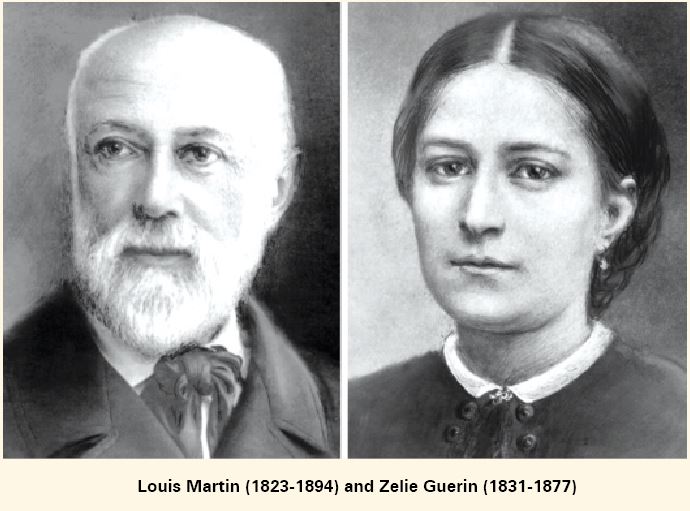
On March 18, 2015, Pope Francis recognized the authenticity of the miracle attributed to the intercession of Blessed Louis and Zelie Martin, the parents of St. Therese of the Child Jesus, thus signing the decree for their canonization. According to Angelo Cardinal Amato, prefect of the Congregation for the Causes of Saints, the canonization should take place in Rome, in October 2015, during the Synod on the Family. They are the first spouses and parents to be canonized in the whole history of the Church.
Both had expressed the wish of entering into religious life before they got married. They gave birth to nine children, but four of them died in their early years. All five daughters who survived became nuns—four of them at the Carmel of Lisieux. The youngest, Therese, was canonized in 1925 and proclaimed Doctor of the Church in 1997. The procedure for the beatification of the other four Martin daughters follows its course.
On March 26, 1994, Pope John Paul II signed the Decree of heroic virtues of Louis and Zelie Martin and proclaimed them both venerable. On January 17, 2008, the medical commission of the Congregation for the Causes of Saints declared as unexplainable by science the healing of young Pietro Schilirò, from Monza, Italy. Born on May 2, 2002, Pietro was afflicted with respiratory problems soon after birth. The sudden cure which took place on June 29, 2002, after a novena of prayer, is attributed to the intercession of God’s venerable servants, Louis and Zelie Martin.
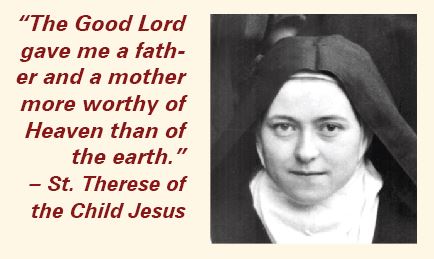 On July 3, 2008, Pope Benedict XVI approved the miracle of Pietro’s cure, allowing for their beatification, and declared that July 12 be the date of their Feast in the liturgical calendar. (Louis and Zelie got married on midnight on July 13, 1858, in Alençon.) Louis and Zelie Martin were beatified, at Lisieux, on Sunday, October 19. 2008. In his homely, Jose Saraiva Cardinal Martins explained the reason for their beatification:
On July 3, 2008, Pope Benedict XVI approved the miracle of Pietro’s cure, allowing for their beatification, and declared that July 12 be the date of their Feast in the liturgical calendar. (Louis and Zelie got married on midnight on July 13, 1858, in Alençon.) Louis and Zelie Martin were beatified, at Lisieux, on Sunday, October 19. 2008. In his homely, Jose Saraiva Cardinal Martins explained the reason for their beatification:
“Among the vocations to which men are called by Providence, marriage is one of the noblest and one of the highest. Louis and Zelie understood that they could sanctify themselves not notwithstanding their marriage, but through their marriage, within it, and by it, and that their engagement must be considered as the starting point of a joint ascension. Today, the Church recognizes in them the eminent sanctity of the institution of conjugal love, as conceived by the Creator Himself.”
The miracle that was recognized in March 2015 for their canonization concerns the unexplainable cure of a Spanish child, Carmen, now age four and living in the diocese of Valencia, in Spain. She was born prematurely and suffered from mutiple complications among which a severe cerebral haemorrhage to which she should not have survived. The medical team that took care of her had to recognize not only a spectacular improvement but the total absence of after-effects, following her parents prayers. They had been advised by friends, since they themselves did not know of the life of the Martin spouses, to ask in prayer and through their intercession, for their daughter’s recovery.
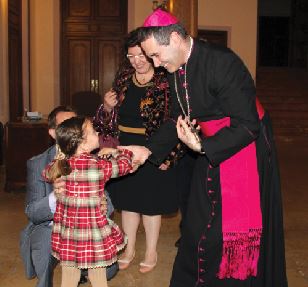 Carmen and her parents with Most Rev. Jacques Habert, Bishop of Sées the diocese to which Alençon belongs), at Valencia, Spain, in May 2013. Carmen and her parents with Most Rev. Jacques Habert, Bishop of Sées the diocese to which Alençon belongs), at Valencia, Spain, in May 2013. |
In canonizing Louis and Zelie Martin, the Church offers to all couples on earth a model that shows that marriage and family life offer a path to sanctity as efficient as that of religious life.
Abbey Saint Joseph of Clairval, France (www.clairval.com), publishes every month a spiritual newsletter on the life of Saints and Blessed. In September 1999, they published the following letter on the future saints, Louis and Zelie Martin (reprinted with permission):
by Dom Antoine Marie, O.S.B.
“Yes, the civilization of love is possible; it is not a utopia. But it is only possible by a constant and ready reference to God, the Father of Our Lord Jesus Christ, from whom all fatherhood in heaven and on earth is named (Eph 3: 14-15), from whom every human family comes” (John Paul II, Letter to Families, February 2, 1994, No. 15). Indeed, it is within the family that the civilization of love is born and grows.
However, “for some time now the family institution has been under repeated attack. These attacks are all the more dangerous and insidious since they ignore the irreplaceable value of the family based on marriage” (John Paul II, June 4, 1999). But “it is not without importance for children to be born and raised in a home made up of parents united in a faithful covenant” (Ibid.). Marriage is this covenant by which “a man and a woman constitute between them a community for life, ordained by its natural character for the benefit of the couple as well as for the procreation and education of children” (Code of Canon Law, c. 1055, § 1). Respect for such a union has “a very decisive bearing on the continuation of the human race, on the personal development and eternal destiny of the individual members of a family, and on the dignity, stability, peace and prosperity of the family itself and of human society as a whole” (Vatican II, Gaudium et spes, 48). That is why the Church strongly defends the identity of marriage and the family. To this end, the Church puts forth the example of the “loving spouses that were Louis and Zelie Martin, the parents of Saint Thérèse of Lisieux,“ who were beatified on October 19, 2008.
Louis Martin was born on August 22, 1823, in Bordeaux, the second of five children. His father, a career officer, was in Spain at the time. The Martin family went from one of their father’s garrisons to another: Bordeaux, Avignon, Strasbourg. At the time of his retirement, in December, 1830, Captain Martin set up house in Alençon, in Normandy. He was an officer of exemplary piety. The regimental chaplain had once mentioned to him that the soldiers were surprised to see him, during Mass, remain so long on his knees after the Consecration, and he responded without batting an eye: “Tell them it is because I believe!” Louis received a very strong religious upbringing, first in the family and then with the Brothers of Christian Schools. He did not choose the traditional family career of the military, but instead became a watchmaker, which went better with his quiet and meditative nature and with his great manual dexterity. He did his apprenticeship first at Rennes, and then at Strasbourg.
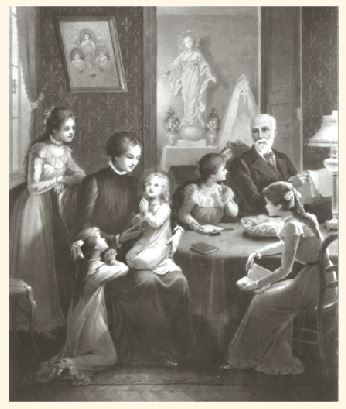 At the beginning of Autumn, 1845, Louis made the decision to devote his life entirely to God. He went to the Great Saint Bernard Hospice, in the heart of the Alps, where the canons were dedicated to prayer and to saving travelers stranded in the mountains. He met the Prior, who asked him to return home to complete his studies in Latin, with the eventual possibility of entering the Novitiate. After an unproductive attempt to take up his studies somewhat late, Louis regretfully decided not to pursue his dream. In order to refine his apprenticeship, he moved to Paris. After that, he returned home to Alençon and lived there with his parents, leading a very orderly life, which made his friends remark, “Louis is a saint.” Busy with his different jobs, Louis did not think about getting married. His mother regretted his decision, but at the lace-making school, where she was taking some courses, she noticed a young woman who was talented and had good manners. Could this be the “pearl” that she sought for her son? The young woman was Zelie Guerin, born at Gandelain, in the Orne (Normandy), on December 23, 1831, the second of three children. Her father and mother were from profoundly Christian families. In September, 1844, they moved to Alençon, where their two older daughters received an education at a boarding school under the guidance of the Sisters of the Sacred Heart of Picpus.
At the beginning of Autumn, 1845, Louis made the decision to devote his life entirely to God. He went to the Great Saint Bernard Hospice, in the heart of the Alps, where the canons were dedicated to prayer and to saving travelers stranded in the mountains. He met the Prior, who asked him to return home to complete his studies in Latin, with the eventual possibility of entering the Novitiate. After an unproductive attempt to take up his studies somewhat late, Louis regretfully decided not to pursue his dream. In order to refine his apprenticeship, he moved to Paris. After that, he returned home to Alençon and lived there with his parents, leading a very orderly life, which made his friends remark, “Louis is a saint.” Busy with his different jobs, Louis did not think about getting married. His mother regretted his decision, but at the lace-making school, where she was taking some courses, she noticed a young woman who was talented and had good manners. Could this be the “pearl” that she sought for her son? The young woman was Zelie Guerin, born at Gandelain, in the Orne (Normandy), on December 23, 1831, the second of three children. Her father and mother were from profoundly Christian families. In September, 1844, they moved to Alençon, where their two older daughters received an education at a boarding school under the guidance of the Sisters of the Sacred Heart of Picpus.
Zelie considered a religious life, just as her older sister had, who became Sister Marie-Dosithee at the Visitation Convent in Le Mans. But the Mother Superior of the Daughters of Charity, of whom Zélie had requested admission to the order, told her without hesitation that such was not the Divine Will. Faced with such a categorical statement, the young woman submitted, but she was saddened. In a wonderful supernatural optimism, she cried out, “My God, I will enter into the state of marriage in order to fulfill Your holy will. Therefore I pray that You give me many children and that they be consecrated to You.” Zelie then entered into a lace-making school in order to become expert in making Alençon lace, a highly regarded form of lace-making. On December 8, 1851, she received an inspiration: “Make Alençon lace.” From that time, she set up her own shop.
One day, passing by a young man with noble features, she was very impressed by his reserved appearance and dignified bearing, and she heard an interior voice tell her, “He is the one I have prepared for you.” She soon learned that the name of the passerby was Louis Martin. The two young people quickly came to value and love one another. Their engagement was so quickly arranged that they were able to marry on July 13, 1858, three months after their initial meeting. Louis and his wife proposed to each other to live as brother and sister, following the example of Saint Joseph and the Virgin Mary. Ten months of life together in total continence permitted them to mold their souls into an intense spiritual communion. But a prudent intervention by their confessor and the desire to give children to the Lord made them put an end to this holy experiment. Zelie would later write to her daughter Pauline: “As for me, I wished to have many children so that I could raise them for Heaven.” In less then thirteen years, they would have nine children. Their love would be beautiful and productive.
“A love which is not ‘beautiful,’ but reduced only to the satisfaction of concupiscence, or to a man’s and a woman’s mutual ‘use’ of each other, makes persons slaves to their weaknesses” (Letter to Families, 13). From this point of view, people are used as objects: woman becomes for man an object of pleasure, and vice versa; children become a nuisance to their parents; the family becomes an institution that shackles the freedom of its members. Thus, one finds oneself light years away from true love. “If an individual is exclusively concerned with pleasure, he can reach the point of killing love by killing the fruit of love. For the culture of pleasure, the ‘blessed fruit of your womb’ (Lk 1: 42) becomes in a certain sense an ‘accursed fruit,’ that is to say, undesirable, which one wants to suppress through abortion. This culture of death is opposed to divine law: The law of God is univocal and categorical with respect to human life. God commands: ‘You shall not kill’ (Ex 20: 13). No human lawgiver can therefore assert: it is permissible for you to kill, you have the right to kill, or you should kill” (Letter to Families, 21).
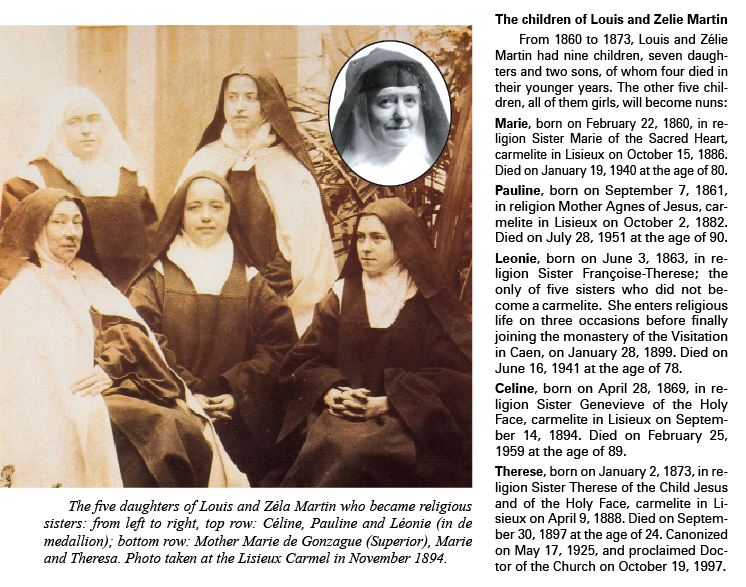
“However,” the Pope continues, “there is a new and growing sense of respect for life from the first moment of conception, especially among young people« This is a leaven of hope for the future of the family and of all humanity.” (Ibid.) Indeed, in the newborn is the realization of the common good of the family and of humanity. The Martin parents experienced this truth by welcoming their numerous children. Zelie would write, “We lived only for our children, they were our total good fortune which we only found through them.” Nevertheless, their married life was not without tests. Three children died at a young age, two of them boys. Then there was the difficult passing away of Marie-Hélène at the age of five and a half. Prayers and pilgrimages followed one upon the other during these trials, especially in 1873, during the serious illness of Therese and Marie’s typhoid. Zelie’s trust during the greatest difficulties was fortified by the sight of the faith of her spouse, in particular his strict observance of Sunday rest: Louis never opened his shop on Sunday. It was the “Good Lord’s feast” that they celebrated together as a family, first at the parish services, then by taking long walks. They took the children to festivals at Alençon, punctuated by parades and fireworks. The upbringing of the children was at one and the same time joyous, gentle, and strict. Starting at the age when they could understand, Madame Martin taught them the morning offering of their heart to the Good Lord, the simple acceptance of daily difficulties “to please Jesus”—indelible trait that would serve as the basis of the “little way” taught by their youngest child: the future Saint Therese of the Child Jesus. “Thus the home is the first school of Christian life,” as taught by the Catechism of the Catholic Church (CCC, 1657). Louis helped his spouse with the child-rearing. He got started early at four o’clock in the morning, seeking a nursemaid for one of his younger children who was ill; he accompanied his wife 10 kilometers from Alençon on a frigid night to be at the bedside of their first son Joseph; he cared for his eldest, Marie, who was stricken with typhoid fever at the age of 13.
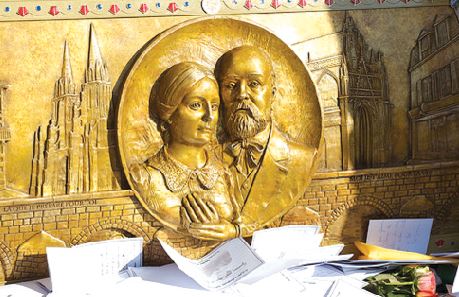 Louis and Zelie Martin reliquary Louis and Zelie Martin reliquary |
Very energetic, Louis Martin was not the «gentle dreamer» that has sometimes been described. In order to help Zelie, who was unable to keep pace with the success of her lace-making business, he abandoned watchmaking to find retail outlets for her work. Louis excelled in this business aspect and considerably increased the revenues of the business. But he also knew how to find time to relax and to go fishing.
In addition, the Martin couple took part in several pious associations: the Third Order of Saint Francis, nocturnal adoration, etc. They drew strength in the loving observation of the precepts and counsels of the Church: fasting, abstinence, daily Mass, frequent confession. Pope John Paul II wrote to families, “God’s strength is always far more powerful than your difficulties! Much more influential than the corruption present in the world is the divine power of the Sacrament of Reconciliation... And incomparably greater than all is the power of the Eucharist« In it Christ has given us Himself as food and drink, as a source of saving power« The life that comes from Christ is for you, dear Spouses, Parents and Families! Did Jesus not institute the Eucharist in a family-like setting during the Last Supper?« The words He then pronounced retain all the power and wisdom of the sacrifice of the Cross» (Letter to Families, 18).
At the source of the Eucharist, Zelie drew energy beyond the reach of most women, and her husband found tenderness beyond the reach of the average man. Louis managed the finances. He happily went along with his wife’s requests: “For Marie’s retreat at the Visitation,” Zelie wrote to Pauline, “you know how difficult it is for your dad to leave you, and first he had said forcefully that she wouldn’t go... Last night, Marie was upset about his stance; I said to her, ‘Let me take care of it, I always get what I want without a fight; there’s still a month before you go; that’s enough time for me to change your father’s mind ten times.’ I wasn’t mistaken, because hardly an hour later, when he came home, he started talking very kindly about your sister (Marie)... ‘Good,’ I said to myself, ‘now is the time!’ And I brought up this business. ‘You really want to make this retreat?’ Dad said to Marie. She answered, ‘Yes, Dad.’ He answered, ‘Fine, then go!’ I did have a good reason for wanting Marie to make the retreat. It’s true that it is an expense, but money is nothing when it comes to the sanctification of a soul; and last year, Marie came back completely changed. The fruit has lasted even until now, but it is time that she replenish her supplies.”
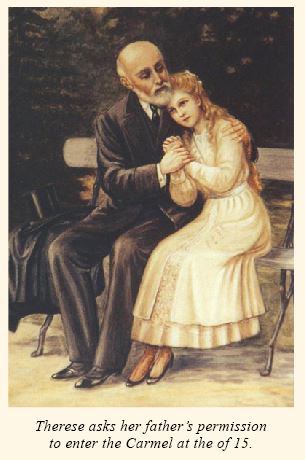 |
Spiritual retreats produce fruits of conversion and sanctification, because under the influence of their energy, the soul, susceptible to the inspirations and actions of the Holy Spirit, always purifies itself more of sins, practices the virtues, imitating the absolute model of Jesus Christ, in order to arrive at a more intimate union with Him. That is why Pope Paul VI was able to say: “Faithfulness to annual spiritual exercises in a sheltered milieu assures the progress of the soul.” Among all the methods of spiritual exercise, “one has ever held the foremost place and the full and repeated approbation of the Holy See... the method introduced by St. Ignatius of Loyola, whom we are pleased to call the chief and peculiar Master of ‘Spiritual Exercises’” (Pius XI, Encyclical Mens Nostra).
The deeply Christian life of the Martin parents was naturally inclined to charity towards their neighbors: discrete donations to needy families, in which the daughters participated depending upon their age, and helping the sick. They were not afraid to engage in legal battles to aid the oppressed. In addition, together they took the necessary steps to help an indigent person enter a hospice, to which he did not have the right, since he was not old enough. These actions went beyond the scope of the parish and showed a great missionary spirit: large annual offerings to the Propagation of the Faith, participation in the building of a church in Canada, etc.
But the intense family happiness of the Martins was not to last long. Starting in 1865, Zélie noticed a tumor in her breast, which first appeared after she bumped into the corner of a piece of furniture. Her brother, a pharmacist, and her husband didn’t think it was of any importance. But at the end of 1876, the disease returned and a formal diagnosis was made: “inoperable fibrous tumor” because it was in an advanced stage. Zelie was valiant to the end. Conscious of the void that her passing would leave, she asked her sister-in-law, Madame Guerin, to help her husband raise the youngest children after her death.
Madame Martin passed away on August 28, 1877. For Louis, 54 years old, it was devastating, a deep wound that would only be closed in Heaven. But he accepted it all with an exemplary spirit of faith and the conviction that his «saintly wife» was in Heaven. He would complete, without fail, the task started in the harmony of love: raising five daughters. For that, Therese wrote, “Papa’s very tender heart joined a truly motherly love to the love that it already possessed.” Madame Guerin offered to help the Martin family and asked her brother-in-law to move the family to Lisieux. Her husband’s drugstore would be a second home for the little orphans, and the intimacy that united the two families only grew, in the same traditions of simplicity, work and uprightness. Despite the memories and the faithful friendships that could have kept them at Alençon, Louis accepted the sacrifice and moved to Lisieux.
Life at the “Buissonets,” the new home in Lisieux, was more austere and withdrawn than in Alençon. The family had little social interaction and cultivated the memory of her that Mr. Martin always spoke of to his children as “your saintly mother.” The youngest girls were placed under the care of the Benedictines of Notre-Dame du Pré. But Louis knew how to provide them with distractions: visits to the theater, trips to Trouville, a stay in Paris, etc., seeking, through all the realities of life, the glory of God and the sanctification of souls.
His personal sanctity was revealed above all in the offering of all of his daughters, and then of himself. Zelie had already foreseen the vocation of the two oldest girls: Pauline entered the Carmel of Lisieux in October 1882, and Marie in October 1886. At the same time Léonie, a difficult child, began a series of fruitless attempts, first with the Poor Clares, then at the Visitation convent, where after two failures she was able to enter definitively in 1899. Therese, the youngest, the “little Queen,” was to overcome every obstacle in order to enter Carmel at the age of 15, in April 1888. Two months later, on June 15, Celine revealed to her father that she too felt called to the religious life. Faced with this new sacrifice, Louis Martin’s reaction was splendid: “Come, let us go together to the Blessed Sacrament to thank the Lord who has given me the honor of taking all of my children.”
Pope John Paul II has written: “You, Parents, thank the Lord if He has called one of your children to the consecrated life. As it has always been, one should feel very honored that the Lord esteems your family and has chosen one of its members and invited them to follow the way of the evangelical counsels. Retain the desire to give one of your children to the Lord for the growth of the love of God in the world. What fruit of married love could be more beautiful than that?” (Apostolic Exhortation Vita consecrata, March 25, 1996, No. 107).
A vocation is above all a divine initiative. But a Christian upbringing favors a willing response to the call of God: “It is in the bosom of the family that parents are by word and example the first heralds of the faith with regard to their children. They should encourage them in the vocation which is proper to each child, fostering with special care any religious vocation» (CCC, 1656). In addition, «if parents do not live according to the values of the Gospel, the young boy or girl will have difficulty hearing the call, or understanding the necessity of the sacrifices to consent to or appreciate the beauty of the goal to be attained. It is indeed in the family that young people first experience the values of the Gospel, of the love that is given to God and to others. It is also necessary that they be raised to responsibly use their freedom, in order to be prepared to live, according to their vocation, the highest spiritual realities” (Vita consecrata, ibid.).
Saint Therese of the Child Jesus and of the Holy Face would testify to the manner in which her father actually lived the Gospel: “What I noticed the most was the progress that Dad made in perfection; following the example of Saint Francis de Sales, he was able to come to master his natural vivacity to the point that he appeared to have the most gentle nature in the world. The things of this world hardly seemed to affect him; he easily overcame the difficulties of this life.” In May 1888, Louis retraced the stages of his life, during a visit to the church where he had celebrated his marriage. He afterwards told his daughters: “My children, I have come back from Alençon, where I received in the Church of Our Lady such great graces, such consolations, that I said this prayer: ‘My God, it is too much! Yes, I am too happy, it is not possible to go to Heaven like that, I want to suffer something for you! And I offered myself...” The word “victim” trailed off on his lips; he dared not pronounce it, but his daughters understood.
God did not delay in hearing His servant. On June 23, 1888, afflicted by increasing arteriosclerosis that affected his mental capacities, Louis Martin disappeared from his house. After much anxiety, he was found at Le Havre, on the 27th. It was the beginning of a slow and inexorable physical failure. Shortly after Therese took the habit, where he appeared “so handsome, so dignified,” he was the victim of a crisis of delirium that required his admittance to Good Saviour Hospital in Caen: a humiliating situation that he accepted with an extraordinary faith. When he was able to express himself, he repeated: “Everything for the greater glory of God,” and also: “I have never been humiliated in my life, I need to be humiliated.” When his legs were paralyzed, in May, 1892, they brought him back to Lisieux. “Good-bye, see you in Heaven!” he was barely able to say to his daughters during his last visit to Carmel. He passed away quietly after a heart attack, on July 29, 1894, attended by Celine who had put off her entrance to Carmel in order to take care of her father.
Saint Therese of the Child Jesus and of the Holy Face would say: “The Good Lord gave me a father and a mother more worthy of Heaven than of the earth.” May we, following their example, arrive at the eternal dwelling place that the Saint of Lisieux called “the Paternal Home of Heaven.”
Dom Antoine Marie, O.S.B.